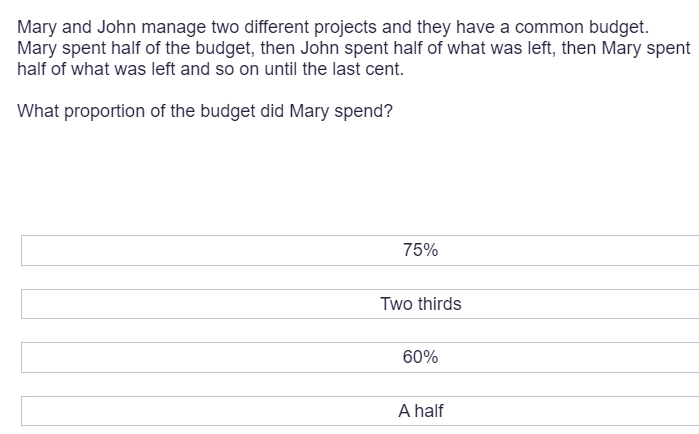AI tutor
Welcome to Bytelearn!
Let’s check out your problem:

Mary and John manage two different projects and they have a common budget. Mary spent half of the budget, then John spent half of what was left, then Mary spent half of what was left and so on until the last cent.What proportion of the budget did Mary spend?Two thirdsA half
Full solution
Q. Mary and John manage two different projects and they have a common budget. Mary spent half of the budget, then John spent half of what was left, then Mary spent half of what was left and so on until the last cent.What proportion of the budget did Mary spend?Two thirdsA half
- Calculate Mary's Expenditure: Let's assume the total budget is for simplicity, which makes it easier to calculate percentages. Mary spends half of the budget first.Mary's expenditure =
- Calculate John's Expenditure: After Mary's expenditure, the remaining budget is . Then John spends half of what is left.John's expenditure = Remaining budget after John's expenditure =
- Calculate Mary's Second Expenditure: Mary then spends half of the remaining budget again.Mary's second expenditure =
- Calculate Sum of Mary's Expenditures: We notice a pattern here: Mary spends half of the remaining budget each time. This is a geometric series where Mary's expenditures are , , , and so on.The sum of an infinite geometric series can be calculated using the formula , where is the first term and is the common ratio.In this case, and (because each subsequent amount is a quarter of the previous one).Sum of Mary's expenditures =
- Calculate Mary's Proportion of Budget: The sum of Mary's expenditures is of the total budget. To express this as a percentage, we multiply by . Mary's proportion of the budget =
More problems from Multi-step problems with percents
QuestionGet tutor help
QuestionGet tutor help
QuestionGet tutor help
QuestionGet tutor help
QuestionGet tutor help
